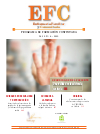EDITORIAL
Presentación
Enrique Oltra Rodríguez
A la pregunta planteada en el título se podría contestar con un: de entrada no, luego... ya veremos. Trataré de explicarlo.España es el país europeo que más especialidades médicas tiene: 43, alguna de ellas de gran similitud o paralelismo, más otras 2 que han sido creadas recientemente [...]
COMPETENCIAS ENFERMERAS
CUIDADOS EN COMPETENCIAS CLÍNICAS GENERALES
Competencias enfermeras en el proceso de duelo
Nursing competencies in the grieving process
Manuel López Morales, Mª Dolores Cano-Caballero Gálvez, Matilde Celma Vicente, María Rodríguez López
La muerte es un tabú social que los profesionales de la salud comparten y para cuyo afrontamiento están, en general, mal preparados. La actitud de huida y desapego emocional actúa en detrimento de la calidad de los cuidados que reciben, en la fase final de la vida, los pacientes y sus familiares. El duelo mal afrontado puede complicarse y perpetuar el dolor de modo innecesario. Saber reconocer los síntomas normales del duelo y distinguirlos del duelo complicado, así como identificar los factores de riesgo que pueden contribuir a complicarlo, son competencias que las enfermeras comunitarias deben desarrollar para poder prestar cuidados de calidad en el proceso de duelo. En el artículo se explican las fases generales que los pacientes y sus familiares viven en el proceso de adaptación a la enfermedad mortal y se recomiendan actitudes profesionales, tanto para facilitar y apoyar el progreso, como para evitar complicaciones y futuros sentimientos de culpabilidad.
In their daily work, health professionals find themselves having to deal with death, which is a social taboo. Quite often they are not sufficiently prepared to confront this issue. They may tend to avoid the topic or show a total detachment. Those attitudes are not any help to the patients that are in the final phase of life, and their families. Coping with death in a bad way, may unnecessarily extend the grief in time. In order to give quality health care, community nurses need to develop a couple of important competences. First of all, they need to be able to distinguish between the normal symptoms of mourning from complicated grief. They also need to identify the risk factors that may cause complicated grief.This paper explains the general phases that patients and their families go through in the process of adapting to a fatal disease. It also recommends the right attitude that health professionals need to show, both to give support and make the process easier, as well as to avoid complicated grief and future feelings of guilt.
GESTIÓN ENFERMERA EN ATENCIÓN PRIMARIA
Estructura del Sistema Nacional de Salud
Structure of the National Health Service
Emilio Velasco Castañon
Los sistemas sanitarios son las diferentes formas de organización para proteger la salud y prestar asistencia sanitaria. Los sistemas sanitarios públicos se desarrollan, con el denominado estado de bienestar. En Europa occidental, existen básicamente dos modelos:
- El sistema de Biskmark o sistema de Seguridad Social
- Tipo Beveridge o Sistema Nacional de Salud (SNS)
En España a finales del siglo XIX comienzan algunas formas de cobertura sanitaria con modelos de aseguramiento a los trabajadores. En 1908 se crea el Instituto Nacional de Previsión, como seguro voluntario para el trabajador. En 1942 nace el Seguro Obligatorio de Enfermedad, dentro del Instituto Nacional de Previsión
La Ley General de Sanidad de 1986 supone un cambio en el modelo del sistema sanitario español, iniciando la denominada reforma sanitaria que tiene como características:
- Abandono del modelo de aseguramiento por uno del tipo sistema nacional de salud, con financiación pública, universal y gratuita.
- Prioridad de la promoción y prevención de salud desde atención primaria.
- Descentralización de la gestión a las Comunidades Autónomas.
El Sistema Nacional de Salud lo forman los Servicios de Salud de las Comunidades Autónomas y de la Administración Central. La atención sanitaria se organiza en dos niveles asistenciales: la atención primaria de salud (APS) y la atención especializada.
La financiación es directa a través de impuestos, dentro del sistema de financiación autonómica
Los modernos sistemas sanitarios deben priorizar aquellas actividades costo-efectivas, en términos de salud y el profesional sanitario debe actuar también con responsabilidad económica dentro del Sistema.
Health Systems are different forms of organization to protect health and give health assistance. Public Health Systems are developed by welfare states. In western Europe there are two different models:
- The Bismark System or Social Security.
- The Beveridge System or National Health Service (NHS).
Health coverage starts in Spain through workers insurances at the end of the 19 th century. In 1908 the Instituto Nacional de Previsión (National Prevision Institute) is created as a voluntary insurance for workers.
In 1942 begins the Seguro Obligatorio de Enfermedad (Compulsory Illness Insurance), inside the Instituto Nacional de Previsión.
In 1986, the Ley General de Sanidad (General Healthcare Law) means a change in the Spanish healthcare system and starts the reforma sanitaria (Healthcare Reform) which main features were:
- Changes the insurances system into a Nacional Health Service with a public, free and universal coverage.
- Gives priority to health promotion and prevention through Primary Health Care.
- Management decentralization from the National Government to Regional Administrations (Comunidades Autónomas).
The Nacional Health Service is formed by the Regional Health Services and the Central Administration Health Services. Health Assistance is organized into two different levels: Primary Health Care and Specialty Care. Funding comes from taxes inside the regional finance system.
Modern Health Systems must prioritize costeffectiveness health activities and health workers must have economical responsability within the System.
CUIDADOS PARA LA PROMOCIÓN Y PREVENCION EN EL ADULTO
Promoción de la salud y prevención de la enfermedad en el adulto
Health promotion and prevention of the disease in the adult
Sara Ribera Freixes. sribera.lleida.ics@gencat.cat
En este artículo desarrollaremos el concepto de salud, analizando algunas de sus principales definiciones y partiendo de la consensuada por la OMS en 1946, que define la salud como el estado de completo bienestar físico, mental y social y no solamente la ausencia de afecciones o enfermedades. Estudiaremos los determinantes de salud de Lalonde como los factores que contribuyen a mantener el equilibrio de la salud: factores biológicos, sistemas sanitarios, factores ambientales y estilos de vida. Examinaremos el concepto de prevención y distinguiremos los tres niveles existentes, dependiendo del momento de intervención: primaria, secundaria y terciaria. Definiremos los principios básicos que rigen la promoción de la salud que entendemos, en su sentido amplio, como cualquier actividad que transforma la conducta, el ambiente o la herencia en un sentido positivo. La educación para la salud es una estrategia amplia de prevención y de promoción de la salud. Analizaremos las dos escuelas existentes en relación a la educación para la salud: la anglosajona y la de Perugia. Para finalizar, daremos un repaso a las actividades preventivas sistemáticas de la edad adulta y los motivos para ponerlas en marcha.
In this article, we are going to develop the health concept analyzing its main definition agreed by the OMS in 1946, which defines health as a complete physical, mental and social welfare and not only the absence of bad conditions or illnesses. We are going to study the determinants of the health by Lalonde as the factors which contribute to keep the balance of the health; biological factors, sanitary equipment, environmental factors, and way of living. We are going to examine the concept of prevention and distinguish the present three levels depending on the time of intervention; primary, secondary and tertiary. We are going to define the basic principal which regulate the promotion of the health in its widest expression, as any activity that can transform the social behavior the atmosphere and the heritage in a positive sense. The education for the health is a wide strategy of prevention and promotion of the health. We are going to analyse the two existing schools related to the education for the health: The Anglo-Saxon and the Perugian. To conclude we are going to revise the preventive systematic activities of the adulthood and the reasons to put them into force
ATENCIÓN A LA SALUD PÚBLICA
Participación Comunitaria en Salud
Community participation in health
María Yolanda Cotiello Cueria
Una de las funciones esenciales de los profesionales de enfermería que trabajan en atención primaria, es el fomento de la participación comunitaria en salud mediante una serie de actividades e intervenciones que, posteriormente, deberán evaluar para conocer si han conseguido o no su objetivo. Pero, ¿qué se entiende por participación comunitaria en salud?, ¿qué intervenciones de enfermería contribuyen a la participación comunitaria en salud?, ¿cómo, cuándo, dónde… desarrollar estas intervenciones? y por último ¿cómo determinar si esas intervenciones de enfermería han sido efectivas?. A través del presente artículo se intentará dar respuesta a dichos interrogantes sin olvidar la dificultad que ello entraña, pues en estos momentos no se sabe muy bien qué se espera de los profesionales de enfermería que trabajan en atención primaria.
One of the essential functions of nursing professionals working in primary care, is to promote community participation in health through a range of activities and interventions that, should subsequently evaluated to determine whether or not to have achieved their goal. But, what is meant by community participation in health?, what nursing interventions contribute to community participation in health?, how, when, where ... develop these interventions? and finally, how to determine whether these interventions have been effective nursing?. Through this article will attempt to answer these questions without forgetting the difficulty that entails, because right now no one knows exactly what is expected of nursing professionals working in primary care.










